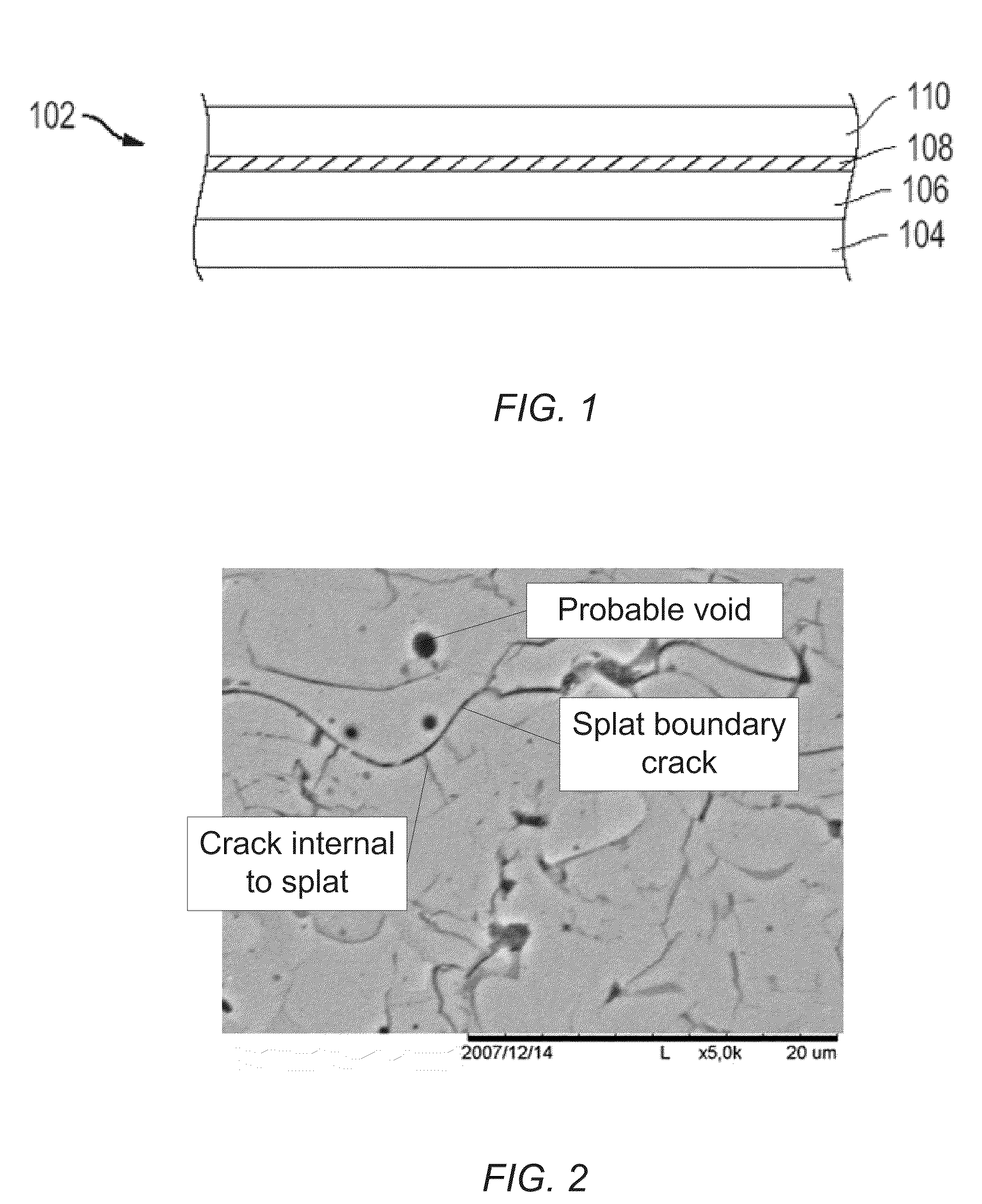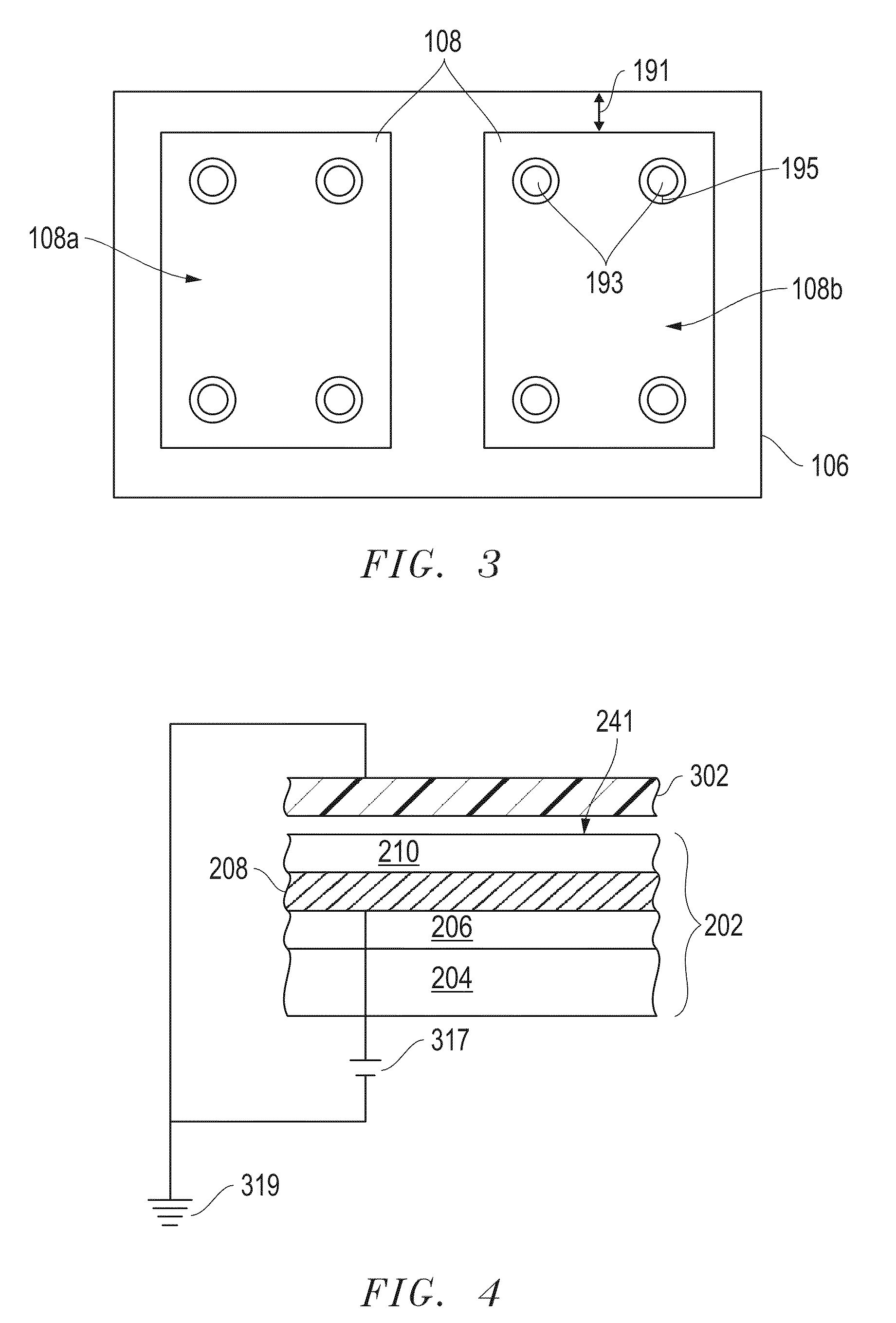Electrostatic chuck and method of forming
a technology of electrostatic chuck and chuck, which is applied in the direction of liquid surface applicators, coatings, pretreated surfaces, etc., can solve the problems of low pressure in the chamber during semiconductor manufacturing processes, and affecting the quality of semiconductor products
- Summary
- Abstract
- Description
- Claims
- Application Information
AI Technical Summary
Problems solved by technology
Method used
Image
Examples
example 1
Comparative Samples, No Infiltration
[0053]Four 6061 aluminum squares 4 cm on a side were grit blasted, plasma sprayed with aluminum oxide to a thickness of about 500 um to provide a porosity about 5%, and then plasma sprayed with tungsten on top to a thickness of about 50 um.
[0054]The samples were tested by applying a steadily increasing DC voltage between the tungsten and the base aluminum and monitoring current. Breakdown was deemed to occur when the current exceeded 2 mA.
TABLE 1Comparative SampleBreakdown voltage (kV)H2.5K10.3N4.7O2.1
[0055]The breakdown voltage varies, with a mean value of only 4.9 kV
example 2
Samples with Infiltration
[0056]Three samples were prepared as for example 1, but with the following addition. HL-126 acrylate monomer (obtained from Permabond LLC of Pottstown, Pa.) was painted onto the surface after spraying. Generous amounts were applied, so that the surface looked well wetted even after a minute or so was allowed for the liquid to soak into the pores. The samples were placed into a vacuum oven and several cycles of evacuation followed by backfill with argon were conducted. This served two purposes: the HL-126 was driven further into the pores and oxygen (which inhibits the cure of the monomer) was removed from the oven.
[0057]Samples were cured for about 2 hours at 120° C. They were then removed from the oven and an area over the tungsten was ground clean so that electrical contact could be established to the tungsten. The samples were then tested as in Example 1, with a maximum applied voltage of 10 kV.
[0058]In no case did breakdown occur, indicating the average ...
example 3
Additional Characterization
[0059]An important attribute of the infiltration process is that infiltrant not be removed by plasma gases. It was found unexpectedly that the infiltrant stays intact for a long time under etch conditions.
[0060]A set of coupons was plasma sprayed with yttrium oxide to a thickness of 100 um using a process that produces 4-5% porosity. They were infiltrated with HL-126 as described in Example 2 above.
[0061]The coupons were etched in a March PM-600 plasma asher (March Plasma Systems Inc., Concord, Calif.), with oxygen at 300W, 250 millitorr for extended times. The amount of infiltrant was determined by monitoring its fluorescence intensity.
[0062]FIG. 5 shows that, after a short initial transient (corresponding to removal of HL-126 from the surface), the infiltrant remains in the pores of the coating for an extended period of time.
[0063]The unexpected retention of infiltrant is not believed to be due to material properties of the infiltrant (which etches relat...
PUM
| Property | Measurement | Unit |
|---|---|---|
| pore size | aaaaa | aaaaa |
| dielectric constant | aaaaa | aaaaa |
| surface area | aaaaa | aaaaa |
Abstract
Description
Claims
Application Information
 Login to View More
Login to View More - R&D
- Intellectual Property
- Life Sciences
- Materials
- Tech Scout
- Unparalleled Data Quality
- Higher Quality Content
- 60% Fewer Hallucinations
Browse by: Latest US Patents, China's latest patents, Technical Efficacy Thesaurus, Application Domain, Technology Topic, Popular Technical Reports.
© 2025 PatSnap. All rights reserved.Legal|Privacy policy|Modern Slavery Act Transparency Statement|Sitemap|About US| Contact US: help@patsnap.com



